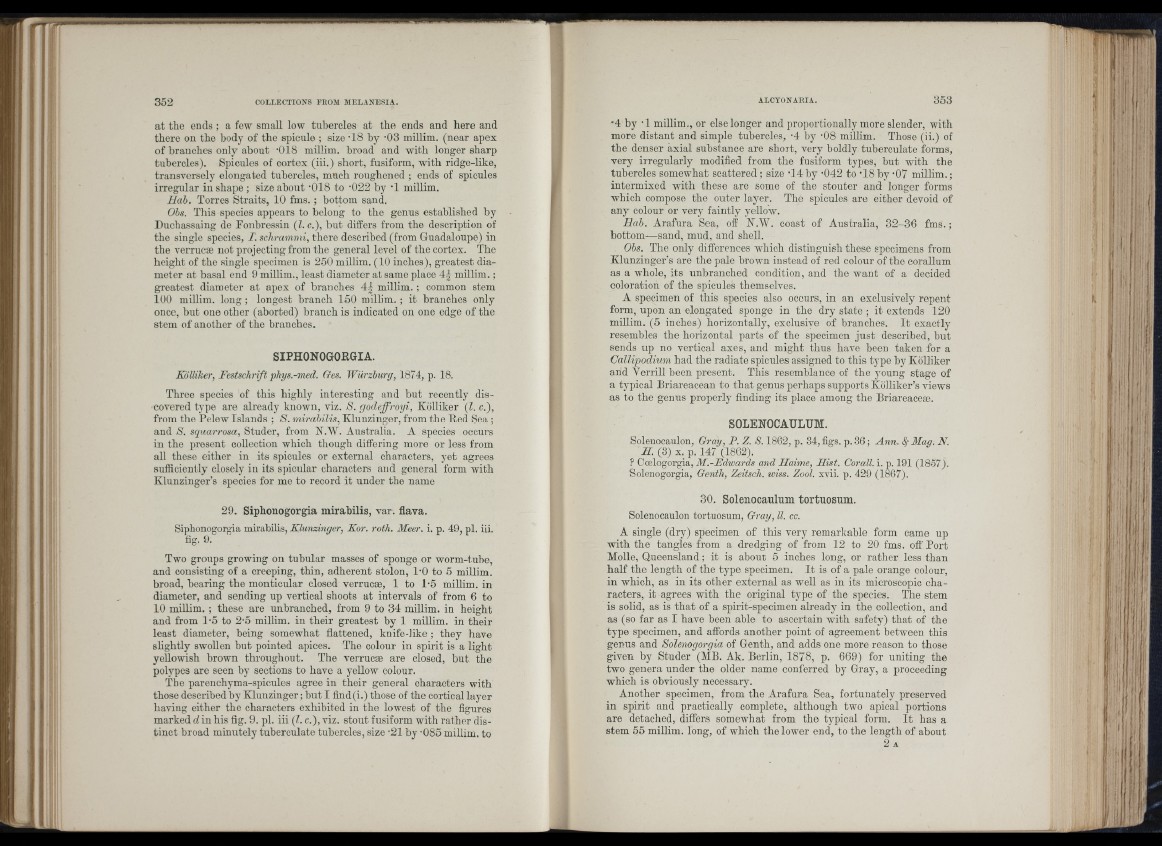
«ifi.I
at the ends ; a few small low tubercles at the ends and here and
there on tho body of the spicule ; size AS by -03 millim. (near apex
of branches only about ‘OIS millim. broad and with longer sharp
tubercles). Spicules of cortex (iii.) short, fusiform, with ridge-like,
transversely elongated tubercles, much roughened ; ends of spicules
irregular in shape ; size about '018 to -022 by A millim.
Hah. Torres Straits, 10 fms. ; bottom sand.
Ohs. This species appears to belong to the genus established by
Duchassaing de Fonhres.sin (Z. r.), but differs from the description of
the single species, T. schrammi, there described (from Guadaloupe) in
the verrucæ not projecting from the general level of the cortex. The
height of the single specimen is 250 millim. (10 inches), greatest diameter
at hasal end 9 millim., least diameter at same place 4^ millim. ;
greatest diameter at apex of branches 4^ millim. ; common stem
100 millim. long ; longest branch 150 millim. ; it branches only
once, but one other (aborted) branch is indicated on one edge of the
stem of another of the branches.
SIPHONOGORGIA.
Kolliker, Festsehiift phys.-med. Ges. Wiirzhurg, 1874, p. 18.
Three species of this highly interesting and but recently discovered
type are already known, viz. S. gocleffroyi, Kolliker (Z. c.),
from the Pelew Islands ; S. mirahilis, Klunzinger, from the lied Sea ;
and S. sqiiarrosa, Studer, from N.AV. Australia. A species occurs
in the present collection which though differing more or less from
all these either in its spicules or external characters, yet agrees
sufficiently closely in its spicular characters and general form with
Klunzinger’s species for me to record it under the name
29. Siphonogorgia mirahilis, var. flava.
Siphonogorgia mirahilis, Klunzinger, Kor. roth. Meer. i. p. 49, pi. iii.
fig. 9.
Two groups growing on tubular masses of sponge or worm-tuhe,
and consisting of a creeping, thin, adherent stolon, I'O to 5 millim.
broad, bearing the monticular closed verrucæ, 1 to P5 millim. in
diameter, and sending up vertical shoots at intervals of from 6 to
10 millim. ; these are unhranched, from 9 to 34 millim. in height
and from 1-5 to 2-5 millim. in their greatest by 1 millim. in their
least diameter, being somewhat flattened, knife-like ; they have
shghtly swollen but pointed apices. The colour in spirit is a light
yeUowish brown throughout. The verrucæ are closed, but the
polypes are seen by sections to have a yeUow colour.
The parenchyma-spicules agree in their general characters with
those described by Klunzinger ; hnt I find(i.) those of the cortical layer
having either the characters exhibited in the lowest of the figures
marked d in his fig. 9. pi. iii (Z. cf), viz. stout fusiform with rather distinct
broad minutely tuberculate tubercles, size '21 by '085 millim. to
•4 by A millim,, or else longer and proportionally more slender, with
more distant and simple tubercles, -4 by -08 millim. Those (ii.) of
the denser axial substance are short, very boldly tuberculate forms,
very irregularly modified from the fusiform types, but with the
tubercles somewhat scattered ; size -14 by -042 to A8 by -07 millim.;
intermixed with these are some of the stouter and longer forms
which compose the outer layer. The spicules are either devoid of
any colour or very faintly yellow.
Rah. Arafura Sea, off N.AV. coast of Australia, 32-36 fm s .;
bottom-—sand, mud, and shell.
Ohs. The only differences which distinguish these specimens from
Klunzinger's are the pale brown instead of red colour of the corallum
as a whole, its unhranched condition, and the want of a decided
coloration of the spicules themselves.
A specimen of this species also occurs, in an exclusively repent
form, upon an elongated sponge in the dry state ; it extends 120
miUim. (5 inches) horizontally, exclusive of branches. I t exactly
resembles the horizontal parts of the specimen ju s t described, but
sends up no vertical axes, and might thus have been taken for a
Callipodium had the radiate spicules assigned to this type by Kolliker
and Verrill been present. This resemblance of the young stage of
a typical Briareacean to th at genus perhaps supports Kolliker’s views
as to the genus properly finding its place among the Briareaceie.
SOLENOCAULUM.
Solenocaulon, Gray, P. Z. S. 1862, p. 34, figs. p. 36; Ann. <2 Mag. N.
H. (3) X. p. 147 (1862).
? Ccelogorgia, M.-Fdivards and Haime, Hist. Corall. i. p. 191 (1857).
Solenogorgia, Genth, Zeitsch. wiss. Zool. xvii. p. 429 (1867).
30. Solenocaulum tortuosum.
Solenocaulon tortuosum, Gray, ll. cc.
A single (dry) specimen of this very remarkable form came up
with the tangles from a dredging of from 12 to 20 fms. off Port
Molle, Queensland; it is about 5 inches long, or rather less than
half the length of the type specimen. I t is of a pale orange colour,
in which, as in its other external as well as in its microscopic characters,
it agrees with the original type of the species. The stem
is solid, as is th a t of a spirit-specimen already in the collection, and
as (so far as I have been able to ascertain with safety) that of the
type specimen, and affords another point of agreement between this
genus and Solenogorgia of Genth, and adds one more reason to those
given by Studer (MB. Ak. Berlin, 1878, p. 669) for uniting the
two genera under the older name conferred by Gray, a proceeding
which is obviously necessary.
Another specimen, from the Arafura Sea, fortunately preserved
in spirit and practically complete, although two apical portions
are detached, differs somewhat from the typical form. I t has a
stem 55 millim. long, of which the lower end, to the length of about
2 a
. I
I. I
1 :
' !